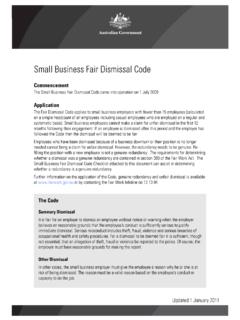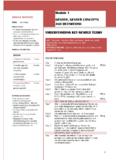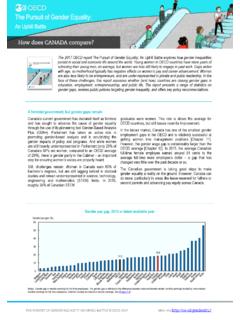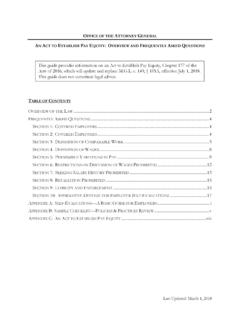Transcription of Best Practice Guide Gender pay equity
1 01 Work & family 02 Consultation & cooperation in the workplace 03 Use of individual flexibility arrangements 04 A Guide for young workers 05 An employer s Guide to employing young workers 06 Gender pay equity 07 Small business & the Fair Work Act 08 Workplace privacy 09 Managing underperformance 10 Effective dispute resolution 11 Improving workplace productivity in bargaining12 Parental leaveFair Work Ombudsman 1 Working at best practiceBest Practice employers take steps to ensure that Gender -based pay discrimination is not part of their remuneration the beginning of the twentieth century when women began to enter the workforce in larger numbers, women were paid less than men, even when they performed the same work. Often women were paid one half or two-thirds of a male s salary. Having a male and female rate of pay is a classic illustration of pay undervaluation of women s work is still embedded in many workplaces.
2 By eliminating discrimination when it comes to wages, employers create fairer working environments. Fairness, respect and equality are essential components of building harmonious, cooperative and productive Best Practice Guide explains: what why the b how tThere is algender pay equity isgender pay inequity happens enefits of Gender pay equityo achieve Gender pay a checklist to assist best Practice Guide illustrates best Practice when it comes to Gender pay equity . For specific information regarding your minimum legal obligations, contact the organisations listed under the For more information section at the end of this Guide . Best Practice Guide Gender pay equity2 Best Practice GuideGender pay equity What is Gender pay equity ? Gender pay equity is when men and women receive equal pay for work of equal or comparable value. In practical terms, this means that best Practice employers ensure that: men athe sa men avalue the wanon-direspojob tythen r the wprocesaccessflexiblnd women performing the same work are paid me amountnd women performing different work of equal are paid the same amountges and conditions of jobs are assessed in a scriminatory way.
3 This is done by valuing skills, nsibilities and working conditions in each job or pe (even where the work itself is different) and emunerating employees accordinglyorkplace s organisational structures and ses do not impede female employees to work-based training, promotions or e working arrangementsCase studies1. Inequalities in part-time and full-time rates of payAlana and Steven both apply for sales positions at Perez Enterprises. They have similar levels of experience and past sales performance. Steven is successful and obtains a full-time position. Alana wants to work part-time to manage family responsibilities. She successfully obtains a part-time position. Perez Enterprises pays Alana a part-time salary. However, Alana realises that if she were working full-time hours she would not be earning as much as is Gender pay inequality as Alana is earning less per hour than Steven even though she is performing the same work. 2.
4 Work of the same valueJohan and Maya both completed three year university degrees in order to enter their professions. Johan is a qualified geologist and Maya is a qualified human resources professional. Both Johan and Maya have five years work experience in their fields and have recently been employed by the same mining company. Maya is employed as the human resources manager and supervises the work of five human resources advisers. Johan is employed in the role of manager geology and supervises the work of five geologists. Even though Maya and Johan are performing different work, a job evaluation of both positions looking at the skills, effort, responsibility and working conditions involved, determined that the work that they perform involves comparable skills and responsibilities. However, Johan is paid a higher salary than Maya. This may be an example of Gender pay inequity, as Johan and Maya are performing work of comparable value, but are receiving different pay.
5 If, however, there was a valid reason for the difference in remuneration for example, if there were a shortage of geologists in the labour market and therefore increased demand then Gender pay inequity may not be the reason for the difference in salary. Differences in pay for men and women for work of comparable value have sometimes been found to be valid where they can be shown to reflect factors unaffected by the sex of the workers, including labour market supply and demand, or differences in industry Work Ombudsman 3 Why does Gender pay inequity happen?According to statistics published by the Australian Bureau of Statistics, there is a pay gap in Australia between women and men. In February 2011, the average weekly earnings for full-time workers were approximately 17% lower for women than for reasons for the gap between earnings for women and men are numerous. A range of historical factors have played a part in creating the Gender pay gap.
6 Today, influencing factors can include: t ihe undervaluation of skills in industries and areas where women predominatewomen s lack of access to work-based trainingdifferent levels of eligibility for discretionary payments such as over-award payments, bonuses and performance paynflexible organisational structures that restrict the employment prospects of workers with family responsibilities. Identifying the reasons why pay inequity may exist in your business is the first step towards fixing the gap. The benefits of Gender pay equityGender pay equity makes good business sense. The benefits to your business of Gender pay equity can include: achiev creatiworkf beco attract improturno fulfilli inspiri prevefrom lpay ining fairness and respect in the workplaceng a motivated, happy and productive orce ming an employer of choiceing and retaining the best and brightest staffving staff retention and thereby reducing ver costsng a business legal obligations ng consumer confidencenting negative public relations issues arising egal proceedings or allegations of Gender equity av attoiding a costly discrimination complaintracting government contracting Gender pay equity in your workplaceIn simple terms, Gender pay equity is about ensuring that both women and men are paid fairly for the work they perform.
7 Equal pay is not just about equal wages. Equal pay takes into account discretionary pay, allowances, performance payments, merit payments, bonus payments and superannuation. Addressing the issue of Gender pay inequity involves understanding where pay disparities may exist in your workplace and giving regard to:Obligati The Fremube pror coremuemplan affCom Once it will agreeother than t An eremuons under the Fair Work Actair Work Commission can make an equal neration order requiring certain employees ovided equal remuneration for work of equal mparable value. An application for an equal neration order can be made by an affected oyee, a union which is entitled to represent ected employee or the Sex Discrimination missioner. an equal remuneration order has been made, prevail over a modern award, enterprise ment, a Fair Work Commission order or any industrial instrument if it is more beneficial hese that contravenes an equal neration order can be liable for a penalty.
8 Obligations under the federal Workplace Gender Equality Act 2012 TAWAleeG FoarwE TmWorwlomtho Tfuhe Equal Opportunity for Women in the Workplace ct 1999 (EOWW Act) has been replaced with the orkplace Gender Equality Act 2012 (WGE Act). l non-public sector employers with 100 or more mployees in their corporate structure (relevant mployers) are required to report to the Workplace ender Equality Agency (WGEA) the 2012-13 reporting period, relevant employers e required to lodge a report comprising a orkplace profile in the same format as under the OWW Act, with no salary data also have to tell employees, shareholders and embers that the report has been lodged with GEA and give them access to a copy. Employee ganisations (eg. unions) with members in the orkplace must also be told that the report has been dged. Employees and employee organisations ay comment on the report to the employer or to e WGEA. These requirements apply from 2012-13 reporting requirements of the WGE Act apply in ll from 2013-14.
9 Relevant employers are required to report on a set of Gender equality indicators. These reports must be signed by the CEO. The Gender equality indicators are: a) Gender composition of the workforce b) Gender composition of governing bodies of relevant employers c) equal remuneration between women and men d) availability and utility of employment terms, conditions and practices relating to flexible working arrangements for employees and to working arrangements supporting employees with family or caring responsibilities e) consultation with employees on issues concerning Gender equality in the workplace f) any other matter specified by the relevant Minister in a legislative Practice GuideGender pay equity Additional minimum standards will apply from the 2014-Obligatiodiscrimin Anti-dan emregarproviother 15 reporting under state, territory and federal anti-ation lawsiscrimination legislation makes it unlawful for ployer to discriminate on the grounds of sex in d to the terms and conditions of employment ded to employees (which includes pay and benefits).
10 Fair Work Ombudsman 5 Best Practice initiativesIn addition to meeting their obligations under legislation, employers can also achieve Gender pay equity through introducing initiatives that respond to the specific needs of their workplaces. A best Practice business will endeavour to identify areas where equal opportunity may be improved and will design and implement policies and practices to achieve improvement. For example, a best Practice business may: ensure tpolicies recognisvalue th provide women of parenand fami Parental ensure tarrangethe samopportu conduct whetherbe impr comparcommewhere gimbalan review othat accemployeassume or night strive to employehat there are transparent remuneration and practices in place e a wide range of skills and appreciate the ose skills can bring to the businessflexible work arrangements to encourage to return to the workplace following a period tal leave (see Best Practice Guide No 1 Work ly and Best Practice Guide No 12 leave )














